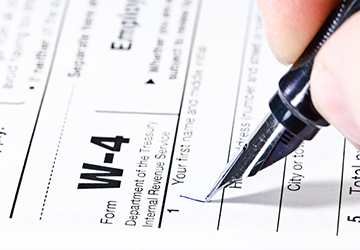Form W-4, more formally known as the "Employee Withholding Certificate," is used by the Internal Revenue Service to notify employers of the amount of tax that should be withheld from an employee's wages. Employers use the W-4 to determine the appropriate amount of payroll tax to be withheld from an employee's paycheck, which is then sent to the IRS and state (if applicable).

Instructions for completing W-4
Follow these instructions to complete the necessary procedures.
Step 1: Details about yourself
Provide your name, postal address, SSN, and tax filing status.
Step 2: consider the possibility of various employment opportunities.
If you're filing jointly and your spouse has a job, or if you have more than one job and want more accurate withholding, follow the instructions.
Complete sections 2 through 4(b) of the W-4 form for the most lucrative position. If you have other occupations, skip these sections when completing Form W-4.
If you and your spouse file jointly and have roughly the same income, you can indicate this on your tax return by ticking the appropriate box. The catch is that both partners must provide their Social Security numbers on their W-4 forms.
There are several ways to avoid revealing to your employer that you work in a second job or receive money from sources other than your regular job. Your employer can take more money from your wages if you ask them to do so in section 4(c). You can also skip including extra cash in your W-4. Send predicted IRS tax payments instead of taking them from your paycheck.
Step 3: make a list of your dependents (including children)
To calculate your credit, multiply the eligible children and dependents by the applicable threshold ($200,000 for single applicants or $400,000 for couples applying jointly). (Read the guidelines for more information on reporting your child as a tax dependent and other eligibility requirements.)
Step 4: Modify the deductions
You can specify that you need more tax withheld than the average amount or that you anticipate deductions in addition to your standard deduction when filing your tax returns.

Step 5: Put your signature and date on the W-4.
Submit the finalized form to your company's Human Resources or Payroll department for processing.
How do I fill out the W-4 form?
You can use Form W-4 to request more deductions from your paycheck if you were charged a high tax bill when you filed your tax return last year and would like to avoid a repeat. This will reduce (or eliminate) your tax debt the next time you file. A considerable tax refund is like giving the government a free loan and can mean settling for less monthly money. Consider submitting a revised Form W-4 to adjust deductions.
Methods of increasing deductions from wages
Reducing the number of W-2 dependents will keep more money for taxes, which may result in a refund when you file your annual return.
What you can do to have less money taken out of your paycheck in taxes
Here's how you can change your W-4 to have less money withheld from your wages, which could result in a tax bill when you file your annual return.
W-4 and Zero Tax Return: How to Achieve Financial Freedom
Ensuring the accuracy of the W-4 form is critical to minimizing or eliminating your annual tax liability.
Make sure you're filing your taxes the right way. If you'd like your withholding tax to reflect your actual tax burden better, you can fill out a new Form W-4, especially if you're filing as head of household and last changed your status a while ago. (Here's a guide to choosing the best tax filing category.
Tips for replenishing W-4
Due to a recent reformatting, Form W-4 now reads:
Employees have been able to reduce the amount of federal income tax withheld from their paychecks by claiming benefits on their W-4s. Employees can reduce the amount their employers deduct from their wages by claiming additional withholding benefits. While personal exemptions were eliminated in the Tax Cuts and Jobs Act 2017, many other tax laws were modified.
For this reason, the Internal Revenue Service has reviewed Form W-4.
The new W-4 will be rolled out in 2020 and will still require basic personal information but will no longer need a few extras. Employees can register as dependents or complete a deduction form to reduce their tax liability.









